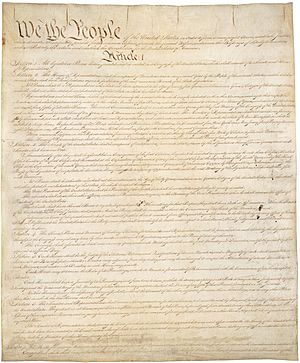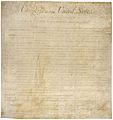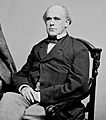Constitution of the United States facts for kids
Quick facts for kids Constitution of the United States |
|
|---|---|

Page one of the original copy of the Constitution
|
|
| Jurisdiction | United States of America |
| Created | September 17, 1787 |
| Presented | September 28, 1787 |
| Ratified | June 21, 1788 |
| Date effective | March 4, 1789 |
| System | Constitutional presidential republic |
| Branches | 3 |
| Chambers | Bicameral |
| Executive | President |
| Judiciary | Supreme, Circuits, Districts |
| Federalism | Federation |
| Electoral college | Yes |
| Entrenchments | 2, 1 still active |
| First legislature | March 4, 1789 |
| First executive | April 30, 1789 |
| First court | February 2, 1790 |
| Amendments | 27 |
| Last amended | May 5, 1992 |
| Location | National Archives Building |
| Commissioned by | Congress of the Confederation |
| Author(s) | Philadelphia Convention |
| Signatories | 39 of the 55 delegates |
| Media type | Parchment |
| Supersedes | Articles of Confederation |
The United States Constitution is the most important law in the U.S.A.. It was signed on September 17, 1787, by a group called the Constitutional Convention in Philadelphia, Pennsylvania. Later, people from the first 13 states approved it. This approval is called ratifying.
When nine states approved the document, they created a union of independent states. They also set up a federal government for this union. This new government began on March 4, 1789. It replaced an earlier agreement called the Articles of Confederation.
The U.S. Constitution is the oldest federal constitution still in use today.
Since 1787, the Constitution has been changed 27 times. These changes are called amendments. The first ten amendments are known together as the Bill of Rights.
Contents
- What Are the Main Parts of the Constitution?
- The Preamble: Why Was the Constitution Written?
- Article One: How Laws Are Made (Legislative Branch)
- Article Two: Carrying Out Laws (Executive Branch)
- Article Three: Interpreting Laws (Judicial Branch)
- Article Four: How States Work Together
- Article Five: How to Change the Constitution (Amendments)
- Article Six: Federal Power and Laws
- Article Seven: Approving the Constitution
- Amendments: Changes to the Constitution
- Images for kids
- See also
What Are the Main Parts of the Constitution?
When it was signed in 1787, the Constitution had a preamble and seven main parts. These parts are called articles.
The Preamble: Why Was the Constitution Written?
The Preamble is the introduction to the Constitution. It says:
- We the People of the United States, in Order to form a more perfect Union, establish Justice, insure domestic Tranquility, provide for the common defense, promote the general Welfare, and secure the Blessings of Liberty to ourselves and our Posterity, do ordain and establish this Constitution for the United States of America.
The Preamble is not a law itself. It explains the reasons for writing the Constitution. It is one of the most famous parts of the document. The first three words, "We the People," are very well-known. The Preamble lists six goals for the Constitution.
Article One: How Laws Are Made (Legislative Branch)
Article One explains that the U.S. Congress will make the laws for the country. Congress is the legislative branch of the government.
Congress has two parts, or "Houses": the United States House of Representatives and the United States Senate. This Article explains who can be elected to each House and how they are chosen.
The House of Representatives has members elected by the people in each state. The number of members from a state depends on how many people live there. Each member of the House is elected for two years.
The Senate has two members, called Senators, from each state. This is true no matter how many people live in that state. Each Senator is elected for six years. At first, state legislatures chose the Senators. But this was changed later by the Seventeenth Amendment.
Article One also explains how Congress works and what kinds of laws it can make. It also lists some laws that Congress and the states cannot make. This Article also sets rules for Congress to remove the President, Vice President, judges, and other government officials from office.
Article Two: Carrying Out Laws (Executive Branch)
Article Two says that the President, Vice President, and other executive offices will carry out the laws. This is the executive branch. This article explains how the President and Vice President are elected. It also says who can be elected to these jobs.
The President and Vice President are elected for four years. They are chosen by a special group called the Electoral College. The Vice President takes over if the President dies, resigns, or cannot do the job.
Article Two also says that the President is the Commander-in-Chief of the U.S. military. The President can make treaties with other countries. However, two-thirds of the Senate must approve these treaties. The President also appoints judges, ambassadors, and other officers. The Senate must approve these appointments too. The President can also veto bills (proposed laws). But Congress can still make the bill a law if enough members vote for it.
Article Three: Interpreting Laws (Judicial Branch)
Article Three creates a court system. This is the judicial branch. It includes the Supreme Court. The Article says that Congress can decide which other federal courts are needed.
Article Three explains what kinds of "cases and controversies" these courts can decide. It also says that all criminal cases must have a trial by jury. This article also defines the crime of treason.
Article Four: How States Work Together
Article Four is about the states. It says that all states must respect the laws of other states. It also says that state governments must treat citizens from other states fairly. If someone is charged with a crime in one state and flees, they must be sent back.
Article Four also says that Congress can create new states. In 1787, there were only 13 states. Now there are 50. It says Congress can make rules for federal property. Congress can also govern territories that are not yet states. Article Four says the U.S. must make sure each state has a republican form of government. It also promises to protect states from invasion and violence.
Article Five: How to Change the Constitution (Amendments)
Article Five explains two ways to amend, or change, the Constitution.
- Congress can write a change if two-thirds of the members in both the House and Senate agree.
- State governments can ask for a convention to write changes. This has not happened since 1787.
Any change written by Congress or a convention must be sent to the state legislatures or to state conventions for approval. Congress decides which way to send the change. Three-fourths of the states must approve a change for it to become part of the Constitution.
An amendment can change any part of the Constitution. But there is one exception: no amendment can change the rule that each state has an equal number of Senators in the U.S. Senate.
Article Six: Federal Power and Laws
Article Six says that the Constitution, and the laws and treaties of the United States, are the highest laws in the country. It also says that all federal and state officials must promise to "support" the Constitution.
Article Seven: Approving the Constitution
Article Seven explained how the new government would start. It said the new government would not begin until at least nine states approved the Constitution.
Amendments: Changes to the Constitution
Since 1787, Congress has proposed 33 amendments to change the Constitution. But the states have only approved 27 of them.
The Bill of Rights (First 10 Amendments)
The first ten amendments are called the Bill of Rights. People discussed them during the Constitutional Convention in 1787. But they were not approved by the states until 1791. These ten changes limit the power of the federal government. They protect the rights of individuals.
| Number | Year | What it Means |
|---|---|---|
| 1st | 1791 | Congress must protect rights like freedom of speech, freedom of the press, and freedom of assembly. People can also ask the government to fix problems (freedom of petition). Congress cannot create a national religion. |
| 2nd | 1791 | People have the right to keep and carry weapons, like guns. |
| 3rd | 1791 | The government cannot force soldiers to live in private homes without the owners' permission. |
| 4th | 1791 | The government needs a good reason (probable cause) to get a warrant to arrest someone or search their property. |
| 5th | 1791 | The government cannot put someone on trial for a serious crime until a grand jury has formally accused them. If found not guilty, a person cannot be tried again for the same crime. The government must follow fair legal steps (due process) before punishing someone or taking their property. A person on trial does not have to speak against themselves in court. |
| 6th | 1791 | Anyone accused of a crime has the right to a quick trial by a jury. They can have a lawyer. They must be told what they are accused of. They can question witnesses against them and bring their own witnesses. |
| 7th | 1791 | A jury trial is required for certain civil cases. |
| 8th | 1791 | The government cannot ask for too much bail or fines. It also cannot use cruel and unusual punishment. |
| 9th | 1791 | The rights listed in the Constitution and Bill of Rights are not the only rights people have. |
| 10th | 1791 | Any power the Constitution does not give to the federal government is left to the states, or to the people. |
Other Amendments (11-27)
After the Bill of Rights, 17 more changes have been made to the Constitution at different times.
| Number | Year | What it Means |
|---|---|---|
| 11th | 1795 | Citizens usually cannot sue states in federal courts. |
| 12th | 1804 | Changed how the President and Vice President are elected. |
| 13th | 1865 | Ended slavery in the United States. |
| 14th | 1868 | Every person born in the U.S. is a citizen. States must follow fair legal steps before taking away a citizen's rights or property. |
| 15th | 1870 | A citizen's right to vote cannot be taken away because of their race, skin color, or if they used to be enslaved. |
| 16th | 1913 | Congress can put a tax on income. |
| 17th | 1913 | The people will now elect Senators. Before this, state legislatures chose them. |
| 18th | 1919 | Made a law against selling or making alcohol, called Prohibition. |
| 19th | 1920 | Gave women the right to vote. |
| 20th | 1933 | Changed the dates for Congress meetings and when the President's term starts. |
| 21st | 1933 | Ended the Prohibition law from the Eighteenth Amendment. States can now make their own laws about alcohol. |
| 22nd | 1951 | A person can only be elected President two times. |
| 23rd | 1961 | Gave people in Washington, D.C. the right to vote for President. |
| 24th | 1964 | Made it illegal to make anyone pay a tax to have the right to vote. |
| 25th | 1967 | Explains what happens if a President dies, resigns, or cannot do the job. It also covers what happens if a Vice President dies or resigns. |
| 26th | 1971 | Set the minimum voting age at 18 years old. |
| 27th | 1992 | Limits how Congress can increase how much its members are paid. |
Images for kids
-
"We the People" in an original edition
-
United States Bill of Rights Currently housed in the National Archives.
See also
- Mayflower Compact
- Fundamental Orders of Connecticut
- English Bill of Rights
- Federalist Papers
- United States Bill of Rights
 In Spanish: Constitución de los Estados Unidos para niños
In Spanish: Constitución de los Estados Unidos para niños












